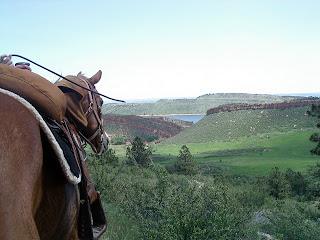As summer is winding down, so is vacation and trail-riding season -- but I want to offer a few suggestions anyway for people who enjoy seeing the world from horseback.
I’ve worked at several trail-riding stables and have led private trail rides for years. I would like to pass on what I’ve learned and point out a few mistakes people make that make the guided ride less fun than it could be.
Most importantly, remember that you will not be doing any real riding at these stables. You are not going to prove your riding ability to anyone doing this kind of riding. The real purpose of guided trail rides is to get a unique tour of the area. Horse trails often go places you can’t reach with other modes of transportation. Horses also move at a unique pace: faster than walking but slower than motorized vehicles. The goal of the ride should be to spend time with horses and enjoy the scenery. With that purpose in mind, here are some tips:
Most importantly, remember that you will not be doing any real riding at these stables. You are not going to prove your riding ability to anyone doing this kind of riding. The real purpose of guided trail rides is to get a unique tour of the area. Horse trails often go places you can’t reach with other modes of transportation. Horses also move at a unique pace: faster than walking but slower than motorized vehicles. The goal of the ride should be to spend time with horses and enjoy the scenery. With that purpose in mind, here are some tips:
- Never claim to have more riding experience than you have -- and estimate low. You don’t want a horse that tends to be spooky, grazes excessively, or otherwise causes problems; those horses will make it much more difficult for you to enjoy the ride. I suggest claiming "no experience" if your pride will allow it; you will get the best horse and be able to enjoy the scenery.
- Listen to your guide. Even if you are an expert rider, these guides know these horses and these trails better than you do. Remember, you are not out to prove your ability. You want to enjoy the ride.
- Dress appropriately. Wear long pants. Wear closed-toe shoes that do not have thick soles which can get caught in stirrups and thus are unsafe. Bring a jacket only if weather conditions in the area suggest that you may need it; you do not need to be taking clothing on and off while riding the horse. Most stables that have issues with weather provide rain jackets and have procedures to follow if it rains while on a ride.
- Do not bring extra supplies. You will be gone for two hours at most and will not need water, snacks or other items that might hang off your body or saddle.
- Stay in line. These horses often do not have experience outside of riding down the trail nose to tail. Do not try to trot, canter, or turn your horse unless absolutely necessary or if your guide tells you it's OK.
- Do not ask your guide to trot, canter or go faster. This prevents you from enjoying the scenery, causes chaos in the line and can cause accidents. Also, the trails are a length that allow you to walk the distance in the time given. The 1-hour ride is a trail that takes approximately an hour for a horse to walk. Guides often do not have other trails to offer if your ride ends up not being a full hour.
- Be careful with your camera. If you bring a camera, make it a small one that is easy to put into and get out of your pocket while you're in the saddle. Make sure it's quiet or turn off any sounds it makes; you do not want to spook your horse.
- Do not force kids to go on a ride. Your ride will be ruined if your child spends the entire ride scared or unhappy. Try a pony ride first to make sure the youngster likes riding. If you still want to go but your child doesn't, find another activity he or she would enjoy while you're gone.
- TIP YOUR GUIDE! If you enjoyed your ride, if you didn’t have accidents or issues, if they tried to entertain you, and if your child’s horse didn’t spend the entire ride with its head in the grass, you guide deserves a tip. Your guide works 12- to 15-hour days. He or she is up before the sun, saddling horses and getting ready for you to come and ride. When your ride is over, your guide has more work to do -- including rides to lead, horses to care for and pens to clean. Guides rely on tips for their income because their salaries are minimal. Because horses are large and unpredictable animals with minds of their own and are easily scared, a good guide who keeps the horses on the trail deserves to be rewarded for getting you back safely.
Remember, your goal is to enjoy your ride and enjoy the scenery. Anything you can do to help make that happen will make your experience much more enjoyable.





No comments:
Post a Comment